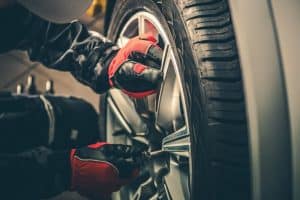Nowadays almost everyone owns a car because of its convenience to move people or goods from one place to another. For as long as every part of your vehicle is intact you will surely enjoy the ride. Tires are the most vital part of a car as they help to stabilize it and keep it on the move.
Therefore, there is the need to ensure that every tire is functioning appropriately. And this begins with understanding every little detail entailing a vehicle tire including balancing. Reading through this article will help you to know when your car tire is out of balance.
What is Tire Balancing?
One may wonder what tire balancing is, especially if they do not know much about cars. Tire balancing also referred to as tire imbalance or tire unbalance is a vehicle maintenance service that is necessary for any car. It outlines the act of distributing mass within the tires or the wheels on which the vehicle is set up.
All areas of the wheel system must have equal weight for your car to roll smoothly and to also have even wear and tear of the tire. Balanced tires also ensure that you enjoy a comfortable ride without any wobbling or bouncing up and down. In addition to this, it improves the life and safety of the tires in general.
Why should you balance tires?
When buying new tires, you should consider balancing them before use. At no time should you assume that the manufacturers have already done the balancing on your behalf. No, it does not work like that.
These new tires may have some imperfections and therefore need balancing. Also, driving on different terrains, especially the rough ones cause your tires to wear out easily. Balancing tires takes care of this problem.
There are occasions where you feel vibrations on your steering wheel or your car seats. This should alarm you that your wheels are not balanced and need to be checked ASAP.
Indications that your tires are out of balance  `
`
It is important to know when your tires are out of balance so as to carry out the necessary precautions to be safe. Below are some of the common tell-tale signs that you should never ignore.
I. Abnormal Vibrations
When you hear certain unusual vibrations from your steering wheel or the floorboard of your car, then this is a sure sign of imbalanced wheels. Normally, it starts from the steering and as you increase the driving speed, the vibrations extend to the front seats in the case of unbalanced front tires and finally to the back seats for the unbalanced back tires.
II. difficulties in controlling the steering wheel
Once you experience difficulty in operating your vehicle’s steering wheel then there is a problem. You will hardly find it easy to steer your vehicle in the direction you want because of an imbalance on your vehicle tires. Due to this, the response time of your steering wheel will reduce and accidents may easily occur in such a case scenario.
III. High rate of fuel consumption
There are times when your vehicle consumes more fuel than normal and you wonder what causes this. Simple! It is because of tires that are out of balance. They have a tendency of exerting excess pressure on your vehicle’s engine which then consumes more fuel in return in order to perform as expected. Spending more on fuel because of tires that are out of balance is not economical. Instead it is better to fix them as a long term solution.
IV. Wearing out of tires in an unequal manner
It is normal for tires to wear out especially if you are a frequent off-road user. But when you notice that some of your tires are worn out while others are not, something is not right. Further, the threads on your tire may also be wearing out unevenly and this is a sign too. Abnormal wearing out will lead to flat tires which may eventually cause an accident.
V. Bad shocks and bearings
Shocks and bearings form part of the tire system on your vehicle as you see above. So when your tires are not balanced, these parts will undergo much strain leading to them wearing and tearing. Failing to balance the tires will make you spend more because apart from changing the tire, there will be a need to replace the shocks and bearings as well.
What to do when your tires are out of balance 
After finding out that your tires are out of balance, you need to find a solution as soon as possible. The best solution is to balance the tires of your vehicle. But how do you go about this? The first option is DIY balancing. Only if you have the right tools such as quick roll for turnplates set for balancing will you be able to do this process on your own. Thus, to be on the safe side do not consider this option entirely.
The second and best option is to visit a mechanic’s workshop. You will find that they have a balancing machine which measures the vibrations on each car tire. Through these measurements, you are able to tell whether your tire needs balancing or not.
If your tires are not balancing, they deal with it there and then and the process does not last long. They do this by applying weights on the tires.
Types of tire balancing
- Static balancing
This involves applying weights across one plane of the tire. It is one of the oldest methods of tire balancing and is very convenient when dealing with light cases of tire balancing. It only needs you to place weights on only one side of the tire, mainly the inside part. So if your tire imbalance is at a complex stage, this method will not work for you.
- Dynamic balancing
Unlike the process above, this involves applying weights across the entire tire, whether up and down or side to side. It is commonly used because it applies modern balancers that spin with the help of a computer. This balancer helps a mechanic to not only identify stiff spots but also measures how much weight the tires need to balance.
- Road-force balancing
This is the latest technology in the wheel balancing area. It employs the use of a machine which presses on a tire using a large roller, thereby applying weight on it. It is able to detect any tire imbalance whether the case is complicated or not. Its main advantage is that it is very precise.
Rebalancing process
- Mount the tire on a wheel and attach it to a tire balancing machine.
- Spin the wheel so as to measure the vibrations which help the mechanic know whether the weight is spread evenly, how much weight you need to add and the spot on which you will apply the weights.
- In the case of an imbalance, the mechanic will only need to add weights to the specific spots. In other cases, the mechanic needs to rotate the tire together with the wheel so as not to miss a heavy spot on the wheel.
DIY process of Tire balancing
If you do not want to visit a mechanic, you can follow the procedure below to attain the best results.
- First of all, make sure you have a wheel balancer to make your work easier. Other than this you need weights, a jack and wrench for the purposes of removing the tire.
- Get your tire and remove all the weights attached to it. Make sure to clean the tire off of any dirt.
- Place the wheel on to the balancer and start measuring the vibrations
- Using a marker pen, ensure to mark all the spots that require more weights.
- Get the weights and add them to the marked spots and measure once again using the balancer.
- Keep on adjusting the weights until the tire is well balanced.
- Place the tire back to its rightful position and repeat this procedure on the other three tires.
Tire Balance vs. Alignment
Oftentimes, people confuse these two terms to mean the same thing. But they are totally different. The only similarity is that both of them are car maintenance services that need to be carried out on your vehicle from time to time.
Tire balancing focuses on protecting your tires against unnecessary wear and tear. On the other hand, tire alignment prioritizes on correcting the tire angles so that they can move in the same direction and get into contact with the road appropriately.
Both of these services have great benefits. Tire balancing enhances the lifespan of your car tires and lets you enjoy a smooth ride. Alignment ensures that your vehicle will not veer off the road while you are driving it.
Conclusion
For the purposes of enjoying a smooth and comfortable ride and keeping your tires from wear and tear, you need to carry out routine balancing on your tires. Now that you are able to tell when your car tire is out of balance, be keen not to miss any of the signs. Deal with the signs as soon as they occur.
